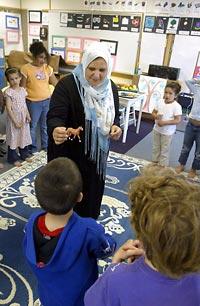Learning Arabic from head to toe

Kamila Abolokma sat in a miniature chair and sliced tomatoes, onions and cucumbers as she counted: "waahid," "ithnayn," "thalaatha," "arbaa," "khamsa," through "ashra," or 10.
Her students drew closer to the table as she made a typical Libyan salad. A mix of Middle Eastern music played in the background. As Abolokma identifies the ingredients, the children repeat back: "zayt" (oil) and "milh" (salt).
It's almost 3 p.m., and the salad snack marked the end of the day at a secular Arabic-language summer camp for kids ages 6 to 12. The students have spent the day — as they have the past two weeks, at the Columbia building, which houses the Orca Elementary School program — coloring, writing, singing, dancing and watching the Arabic version of "Sesame Street." They learn the same way native speakers learn a language — naturally.
"They learn through songs, games, art ... it's like they go from station to station, so they don't feel bored and it's not presented in the old, traditional way," Abolokma said.
The annual language camp, which started in 1998, this year is funded partly by the University of Washington's Middle East Center and arranged by the Seattle-based nonprofit Associates in Cultural Exchange, with the help of Seattle Public Schools. The cost for the camp's 17 participants is $370 each, but many receive scholarships or sibling discounts.
The goal of the program was not to have students become fluent in Arabic. but to give them a positive introduction to the language and culture, said Felicia Hecker, associate director of the UW's Middle East Center.
"Early exposure to any foreign culture is extremely important, and I'm very glad that we're giving some students exposure to Arabic," Hecker said.
Similar Arabic programs exist nationwide, such as the Al-Bustan Camp in Philadelphia, which started in 2002. Concordia Language Villages, an immersion language program in Minnesota, will offer an Arabic camp next summer.
Teachers typically use Modern Standard Arabic, which is the language of formal settings and writing. Colloquial Arabic also is used, but can vary by region. While there are 206 million native speakers of Arabic worldwide, colloquial Arabic is so distinct that an Egyptian, for example, might not understand a Yemeni.
A 2002 Modern Language Association survey found that since 1998, enrollment in Arabic classes at the college level had almost doubled, to 10,584 students from 5,505.
The survey also found that, after American Sign Language, Arabic was the language that saw the largest increase in enrollments.
"The interest has increased not only at the college level but at the K-12 level since 9/11, and that's a definite fact," said Antonia Schleicher, executive director at the Wisconsin-based National Council of Less Commonly Taught Languages and professor of African languages and literature at the University of Wisconsin.
In 1996, the U.S. Department of Education awarded a three-year, $350,000 Foreign Language Assistance Program grant to the state Office of Superintendent of Public Instruction for programs to start world language study in elementary schools. One of the goals was to create a pool of native speakers to become teachers.
The camps — originally teaching Mandarin and Korean — began in 1997 on Mercer Island and in Federal Way. The following year, Arabic, Japanese and Russian were added, all at Meany Middle School in Seattle.
Over the years, languages were added and dropped, funding ran out and was renewed by alternative sources.
Today, in addition to the Arabic camp, Associates in Cultural Exchange, with the help of the YMCA, will offer Spanish and Japanese camps in the area.
Back at Orca Elementary, 12-year-old Omar Farajallah said it's important to learn other languages.
"It helps me to talk both Chinese or Arabic, and it'll help me to apply for a good job," he said. "It'll allow me to meet other people, not just people who speak English ... it'll help me in life."
He and his sister Nadia, 8, were born of a Taiwanese mother who speaks to them in Mandarin, and a father from the United Arab Emirates who speaks to them in Arabic. At home, they also speak English.
It's Nadia's second summer at Arabic camp, father Walid Farajallah said.
"She was coming home and was so excited, reciting a lot of baby rhymes and ... a lot of words in Arabic and their meanings in English and testing me. Mostly she wanted to know if I knew those words."
It's also the second time Fautimah El-Mehrik — whose father is from Libya and mother is American — attended the Arabic camp.
"I'm interested in Arabic because I want to speak to my grandmother," said El-Mehrik, 8, "When I go to school I want to teach my friends to speak Arabic," he added, "so that we can have our secret language."
Other students said they wanted to learn the language because of their heritage and to be able to one day read Islam's holy book, the Quran.
Others, like 8-year-old Mitso Floor, was curious about the camp. His school, Lowell Elementary, offers after-school classes in Arabic, Spanish and Mandarin.
"I just wanted to learn a bit more," Mitso said. "I'd never heard of it, I was just curious ... the alphabet that's way different from English."
The Arabic alphabet is posted on a classroom wall at Orca, next to a wall of colored pictures of vegetables, their Arabic names below. "They love coloring, they think it's art, but they're learning," Abolokma said.
They learn the Arabic version of "Head, Shoulders, Knees and Toes" and point to body parts as they sing. Effortlessly, they repeat: "raas," "aktaaf," "rukab" and "asaabia" — lastly touching their shoeless toes, without needing to ask why.
Seung Hwa Hong: 206-464-3347 or ihong@seattletimes.com


